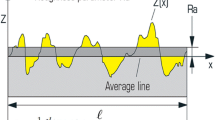Abstract
In this paper, a simple methodology to distribute the total stock removal in each of the rough passes and the final finish pass and a fuzzy particle swarm optimization (FPSO) algorithm based on fuzzy velocity updating strategy to optimize the machining parameters are proposed and implemented for multi-pass face milling. The optimum value of machining parameters including number of passes, depth of cut in each pass, speed, and feed is obtained to achieve minimum production cost while considering technological constraints such as allowable machine power, machining force, machining speed, tool life, feed rate, and surface roughness. The proposed FPSO algorithm is first tested on few benchmark problems taken from the literature. Upon achieving good results for test cases, the algorithm was employed to two illustrative case studies of multi-pass face milling. Significant improvement is also obtained in comparison to the results reported in the literatures, which reveals that the proposed methodology for distribution of the total stock removal in each of passes is effective, and the proposed FPSO algorithm does not have any difficulty in converging towards the true optimum. From the given results, the proposed schemes may be a promising tool for the optimization of machining parameters.
Similar content being viewed by others
References
Iwata K, Murotsu Y, Iwotsubo T, Fuji S (1972) A probabilistic approach to the determination of the optimum cutting conditions. Trans ASME J Eng Ind 94:1099–1107
Gopalakrishnan B, Faiz AK (1991) Machining parameter selection for turning with constraints: an analytical approach based on geometric programming. Int J Prod Res 29:1897–1908
Tolouei-Rad M, Bidhendi IM (1997) On the optimization of machining parameters for milling operations. Int J Mach Tools Manuf 37(1):1–16
Sonmez AI, Baykasoglu A, Dereli T, Filiz IH (1999) Dynamic optimization of multipass milling operations via geometric programming. Int J Mach Tools Manuf 39(2):297–320
Jha NK (1990) A discrete data base multiple objective optimization of milling operation through geometric programming. Trans ASME J Eng Ind 112(4):368–374
Wang J (1993) Constrained optimization of rough peripheral and end milling operations. PhD Thesis, University of Melbourne, Australia
Petropoulos PG (1973) Optimal selection of machining rate variable by geometric programming. Int J Prod Res 11(4):305–314
Shunmugam MS, Bhaskara Reddy SV, Narendran TT (2000) Selection of optimal conditions in multi-pass face-milling using a genetic algorithm. Int J Mach Tools Manuf 40:401–414
An LB, Chen MY (2003) On optimization of machining parameters. In: Proceedings of the 4th International Conference on Control and Automation, pp 839–843
Wang ZG, Rahman M, Wong YS, Sun J (2004) Optimisation of multi-pass milling using genetic algorithm and genetic simulated annealing. Int J Adv Manuf Technol 24:727–732
Saha SK (2009) Genetic algorithm based optimization and post optimality analysis of multi-pass face milling. CoRR abs/0902.0763
Conceição António CA, Castro CF, Davim JP (2009) Optimisation of multi-pass cutting parameters in face-milling based on genetic search. Int J Adv Manuf Technol 44:1106–1115
Kennedy J, Eberhart RC (1995) Particle swarm optimization. In: Proceedings of the IEEE International Conference on Neural Networks, 27 November/December, Perth, Australia, IV. Piscataway, NJ: IEEE Service Centre, pp 1942–1948.
Natarajan U, Periasamy VM, Saravanan R (2007) Application of particle swarm optimisation in artificial neural network for the prediction of tool life. Int J Adv Manuf Technol 31:871–876
Gandhi AK, Kumar SK, Pandey MK, Tiwari MK (2010) EMPSO-based optimization for inter-temporal multi-product revenue management under salvage consideration. Appl Soft Comput J. doi:10.1016/j.asoc.2009.12.006
Yang ZG, Zhou YS, Wu M (2005) Application of improved particle swarm optimization in economic dispatching. Power Syst Technol 29(2):1–4
Jerald J, Asokan P, Prabaharan G, Saravanan R (2005) Scheduling optimization of flexible manufacturing systems using particle swarm optimization algorithm. Int J Adv Manuf Technol 25:964–971
Lee TS, Ting TO, Lin YJ, Htay T (2007) A particle swarm approach for grinding process optimization analysis. Int J Adv Manuf Technol 33:1128–1135
Srinivas J, Giri R, Yang SH (2009) Optimization of multi-pass turning using particle swarm intelligence. Int J Adv Manuf Technol 40:56–66
Higashi N, Iba H (2003) Particle swarm optimization with Gaussian mutation. In: Proceedings of the IEEE Swarm Intelligence Symposium 2003 (SIS 2003), Indianapolis, Indiana, USA, pp 72–79
Nefedov N, Osipov K (1987) Typical examples and problems in metal cutting and tool design. Mir Publishers, Moscow
Jain NK, Jain VK (2007) Optimization of electrochemical machining process parameters using genetic algorithm. Mach Sci Technol 11:235–258
Coello CA (2000) Use of self-adaptive penalty approach for engineering optimization problems. Comput Ind 41(2):113–127
Deb K (1997) GeneAS: a robust optimal design technique for mechanical component design. In: Dipankar Dasgupta and Zbigniew Michalewicz (eds) Evolutionary algorithms in engineering applications, Springer, pp 497–514
Deb K (1991) Optimization design of a welded beam via genetic algorithm. AIAA J 29(11):2013–2015
Arora JS (1989) Introduction to Optimum Design. McGraw-Hill.
Hu XH, Eberhart RC, Shi YH (2003) Engineering optimization with particle swarm. In: Proceedings of the IEEE Swarm Intelligence Symposium 2003 (SIS 2003), Indianapolis, Indiana, USA, pp 53–57
Acknowledgment
This work was supported by the National Defense Foundation of China under grant D2520062. The authors would like to express their sincere appreciation to the referees for their detailed and helpful comments to improve the quality of the paper.
Author information
Authors and Affiliations
Corresponding author
Rights and permissions
About this article
Cite this article
Yang, Wa., Guo, Y. & Liao, Wh. Optimization of multi-pass face milling using a fuzzy particle swarm optimization algorithm. Int J Adv Manuf Technol 54, 45–57 (2011). https://doi.org/10.1007/s00170-010-2927-5
Received:
Accepted:
Published:
Issue Date:
DOI: https://doi.org/10.1007/s00170-010-2927-5




